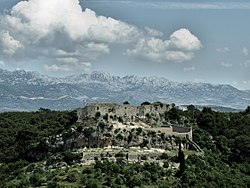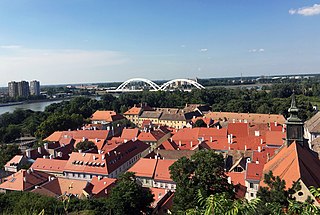
Petrovaradin is a historic town in the Serbian province of Vojvodina, now a part of the city of Novi Sad. As of 2011, the urban area has 14,810 inhabitants. Lying on the right bank of the Danube, across the main part of Novi Sad, it is built around the Petrovaradin Fortress, the historical anchor of the modern city.

Zadar, historically known as Zara, is the oldest continuously inhabited city in Croatia. It is situated on the Adriatic Sea, at the northwestern part of Ravni Kotari region. Zadar serves as the seat of Zadar County and of the wider northern Dalmatian region. The city proper covers 25 km2 (9.7 sq mi) with a population of 75,082 in 2011, making it the second-largest city of the region of Dalmatia and the fifth-largest city in the country.
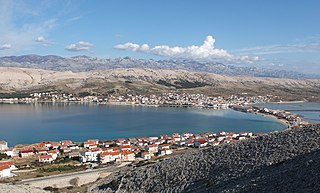
Pag is the largest town on the island of Pag, with a population of 2,343 (2021) in the urban core and 3,178 in the entire municipality.

The Bay of Kotor, also known as the Boka, is a winding bay of the Adriatic Sea in southwestern Montenegro and the region of Montenegro concentrated around the bay. It is also the southernmost part of the historical region of Dalmatia. At the entrance to the Bay there is Prevlaka, a small peninsula in southern Croatia. The bay has been inhabited since antiquity. Its well-preserved medieval towns of Kotor, Risan, Tivat, Perast, Prčanj and Herceg Novi, along with their natural surroundings, are major tourist attractions. The Natural and Culturo-Historical Region of Kotor was designated a UNESCO World Heritage Site in 1979. Its numerous Orthodox and Catholic churches and monasteries attract numerous religious pilgrims and other visitors.

Herceg Novi is a town in Coastal region of Montenegro located at the Western entrance to the Bay of Kotor and at the foot of Mount Orjen. It is the administrative center of the Herceg Novi Municipality with around 33,000 inhabitants. The town was founded as a fortress in 1382 by the King of Bosnia, Tvrtko I Kotromanić, and named after Saint Stephen but the name did not stick, instead it became known as Novi (transl. New), also Castelnuovo in Italian. Between 1482 and 1687 it was part of the Ottoman Empire and then from 1687 to 1797 the Albania Veneta of the Republic of Venice. It was a Catholic bishopric and remains a Latin titular see as Novi. Herceg Novi has had a turbulent past, despite being one of the youngest settlements on the Adriatic. A history of varied occupations has created a blend of diverse and picturesque architectural styles in the city.

The Kingdom of Dalmatia was a crown land of the Austrian Empire (1815–1867) and the Cisleithanian half of Austria-Hungary (1867–1918). It encompassed the entirety of the region of Dalmatia, with its capital at Zadar.

Novigrad is a town in Istria County in western Croatia. It is also sometimes referred to as Novigrad Istarski to distinguish it from three other Croatian towns of the same name.
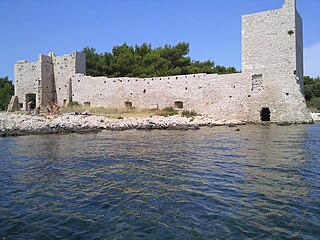
Vir is an island on the Croatian coast of the Adriatic Sea with an area of 22 km2. It lies in Dalmatia, north of the city of Zadar. It is connected to the mainland via a road bridge. The main village on the island is the eponymous village of Vir. There are two more villages, Lozice and Torovi. According to the 2011 census, the island had a population of 3,000 inhabitants, making it the 13th most populous island in Croatia.

Benkovac is a town and municipality in the Zadar County, Croatia.
Janko Mitrović was a harambaša, and the commander of the Morlach army, in the service of the Republic of Venice, from 1648 until his death in 1659. He participated in the Cretan War (1645–69), alongside Ilija Smiljanić, as the supreme commanders of the Venetian Morlach troops, of which he is enumerated in Serb epic poetry. His son, Stojan Janković, followed in his father's footsteps.
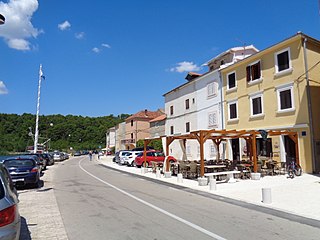
Novigrad is a village and municipality in Croatia in the Zadar County. According to the 2011 census, there were 2,375 inhabitants, absolute majority of whom were Croats.
The Battle of Zadar was a military engagement between the Yugoslav People's Army, supported by the Croatian Serb Serbian Autonomous Oblast of Krajina, and the Croatian National Guard, supported by the Croatian Police. The battle was fought north and east of the city of Zadar, Croatia, in the second half of September and early October 1991 during the Croatian War of Independence. Although the JNA's initial orders were to lift the Croatian siege of the JNA's barracks in the city and isolate the region of Dalmatia from the rest of Croatia, the orders were amended during the battle to include capturing the Port of Zadar in the city centre. The JNA's advance was supported by the Yugoslav Air Force and Navy.

The Klis Fortress is a medieval fortress situated above the village of Klis, near Split, Croatia. From its origin as a small stronghold built by the ancient Illyrian tribe Dalmatae, to a role as royal castle and seat of many Croatian kings, to its final development as a large fortress during the Ottoman wars in Europe, Klis Fortress has guarded the frontier, being lost and re-conquered several times throughout its 2,000-year history. Due to its location on a pass that separates the mountains Mosor and Kozjak, the fortress served as a major source of defense in Dalmatia, especially against the Ottoman Empire. It has been a crossroad between the Mediterranean Sea and the Balkans.
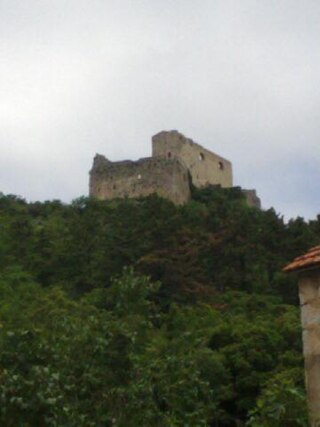
Prozor Fortress is a medieval fortress situated in the continental part of Split-Dalmatia County, in inland Dalmatia, just above the town of Vrlika in Croatia. From its origin as a small stronghold built by the ancient Illyrian tribe Dalmatae, it developed into a fortress in the 15th century, during the reign of Bosnian feudal lord Hrvoje Vukčić Hrvatinić.

Arbanasi is an ethnic community in and around the city of Zadar in the northern Dalmatia region of Croatia, who are of Albanian ethnic origin. They are traditional speakers of the Arbanasi dialect of Gheg Albanian. Their name is an obsolete way to say Albanians in Croatian and is the toponymy of the first Arbanasi settlement in the region, which today is a suburb of Zadar. In Albanian literature, they are known as "Albanians of Zadar".

Knin Fortress is located near the tallest mountain in Croatia, Dinara, and near the source of the river Krka. It is the second largest fortress in Croatia and most significant defensive stronghold, and a historical town in the Šibenik-Knin County in the Dalmatian Hinterland. The construction of the fortress started as early as 9th century, while the current state was brought up in 17th and 18th centuries. It reached its peak during the reign of Demetrius Zvonimir, King of Croatia from 1076, as it served as a political center of the Croatian Kingdom under him.

Ostrovica Fortress is a ruined medieval fortification on a solid rock jutting from the top of the hill above the village of Ostrovica in Zadar County, Croatia. It is located between the two historical and geographical regions, Bukovica and Ravni Kotari. It was once an important stronghold, known as the "Key to the City of Zadar", as it was a key defense of the city. It was destroyed during the Ottoman–Venetian Wars in the second half of the 17th century, leaving only a few remains.
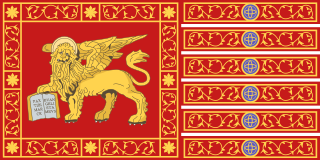
Venetian Dalmatia refers to parts of Dalmatia under the rule of the Republic of Venice, mainly from the 15th to the 18th centuries. Dalmatia was first sold to Venice in 1409 but Venetian Dalmatia was not fully consolidated until 1420. It lasted until 1797, when the Republic of Venice fell to the forces of Napoleon Bonaparte and Habsburg Austria.

St. Michael's Fortress is a medieval fort in Šibenik, Šibenik-Knin County, Croatia, situated on a steep hill above the old historic center of the city. Its strategically favorable and dominant position made it the central part of Šibenik fortification system. The location was more or less continuously occupied since the Iron Age, as is witnessed by numerous archaeological findings from the era. The city of Šibenik was first mentioned on 25 December 1066 in a charter signed by King Peter Krešimir IV and verified by his courtiers. It is widely considered that the signing took place at St. Michael's Fortress.

Squatting in Croatia has existed as a phenomenon since the decline of the Roman Empire. In the 1960s much private housing in major cities was illegally constructed or expanded and since the 1990s squatting is used as a tactic by feminists, punks and anarchists. Well-known self-managed social centres such as the cultural centre Karlo Rojc in Pula, Nigdjezemska in Zadar and (AKC) Medika in Zagreb.
